You’ve probably seen the news stories lately about a remote Russian town being “invaded” by dozens of hungry, garbage-eating polar bears. These bears are roaming around playgrounds, rummaging through the local dump, and even trying to enter office buildings.
A similar incident occurred in 2016, when a sloth of polar bears — yes, that’s the proper collective name — besieged scientists at a research station in the Russian Arctic.
But these news stories don’t paint the full picture of what’s happening to the iconic white bears as climate change takes hold in the north. Are they all starving? Will polar bears go extinct? Why is sea ice so important?
The answers to these questions are complex, but we’ve boiled down the basic facts for you here.
Are Polar Bears Endangered?
Not yet, but they’re not doing great. The IUCN lists the polar bear (Ursus maritimus) as a vulnerable species, one step away from being endangered.
Scientists don’t have exact numbers on the polar bear population, because these animals are spread out over a large area of rough, inhospitable terrain and are very difficult to count. The best estimate is around 25,000 animals in Canada, the United States, Greenland, Norway, and Russia.
There are 19 different subpopulations of polar bears, and depending on where they live, some of these sub-populations are faring better than others. Some are stable, one is increasing, several are in decline, and for the rest we just don’t have good data.
Recently, a controversial report from the Canadian government said that there are too many polar bears in the Canadian Arctic, threatening the safety of Inuit peoples living there. Many scientists disagreed with those findings, stating that bears might appear more numerous because they’re coming into contact with humans more frequently.
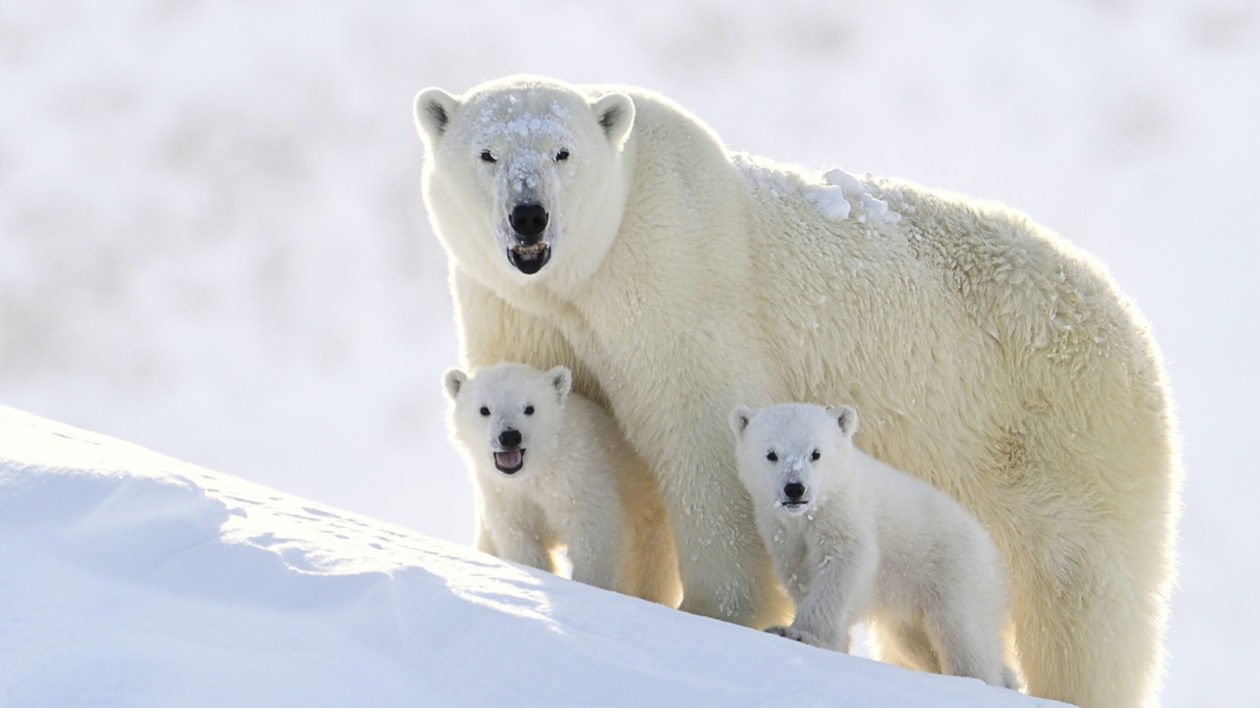
Why is Climate Change Bad for Polar Bears?
Polar bears should really be called ice bears, because ice is key to their survival.
The majority of a polar bear’s diet is made up of seals that live on and around the edge of the sea ice, like ringed seals and bearded seals. Polar bears hunt on the ice, stalking seals as they lounge on icebergs or surface for air at a breathing hole.
The extent of the sea ice changes throughout the year. It reaches its peak in late winter, around the end of March, and then shrinks during the warmer summer months. As the ice melts, polar bears rely more and more on the fat stores they built up during the previous winter. By September the sea ice is at its lowest and bears often struggle to find enough food. Then as winter comes the ice grows, allowing polar bears to hunt more easily.
This reliance on sea ice makes polar bears extremely vulnerable to climate change. The Arctic is warming faster than most other places on earth, and as it warms there’s less and less ice. From 1979 to 2011, the amount of sea ice left in September declined by 14 percent per decade. Sea ice is declining even faster than climate models predict.
Each year the ice takes longer to form, covers less area, and melts faster. Polar bears have less time to hunt on the ice and build up fat reserves for summer, and they must survive on those stores for longer as they wait for the ice to return. Starvation is a risk, and scientists are also concerned that bears will be less likely to breed and have cubs if they can’t find enough food.
Climate change is the single greatest threat to polar bears. Declining sea ice not only deprives bears of their hunting grounds, it also exacerbates other threats. Less ice means that more of the Arctic will be open to oil drilling, commercial shipping, pollution, tourism, and even hunting. These problems already threaten polar bears, and with climate change they will likely get worse.
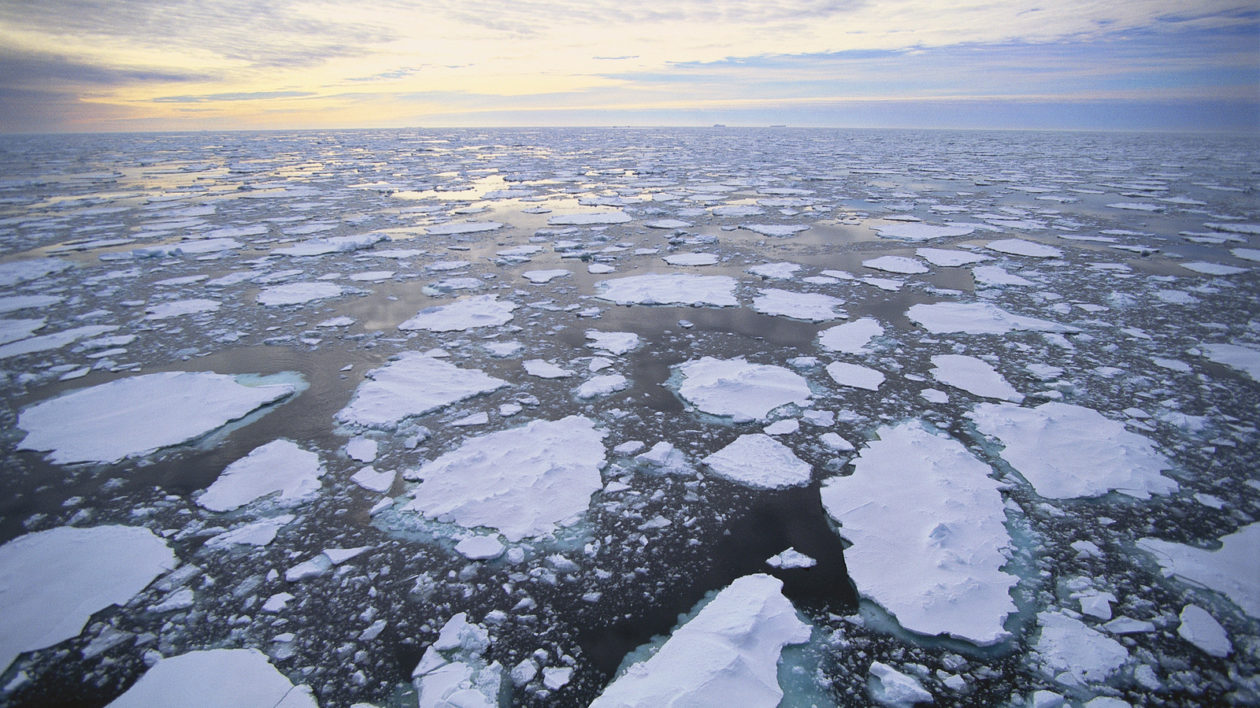
Are Polar Bears Starving?
Yes, but not all of them. Not yet.
About a year ago, a video of a starving polar bear transfixed the internet. Shot by photographer Paul Nicklen, the footage showed an emaciated polar bear stumbling about incoherently, hours away from death. It’s impossible to say that climate change caused this particular bear to starve to death.
But as the sea ice disappears, more and more bears may suffer this fate.
Shrinking ice means the polar bears have less time to hunt and build up fat reserves. It also means they have to travel farther to find their next meal, burning more calories and further depleting their fat stores. Bears may have to swim greater distances between ice packs, which puts little cubs at risk of drowning.
Polar bears are even more reliant on a diet of fat-rich seals than scientists previously thought. In one study, researchers used Fitbit-like activity monitors and GPS collars with cameras to monitor bears’ activity and hunting over a 8 to 10 day period. They calculated that an adult polar bear needs to eat at least one adult ringed sea (or three juveniles) every 10 days. Four bears in the study didn’t meet that baseline, and in less than 2 weeks they lost almost 10 percent of their body mass, or about 40 pounds.
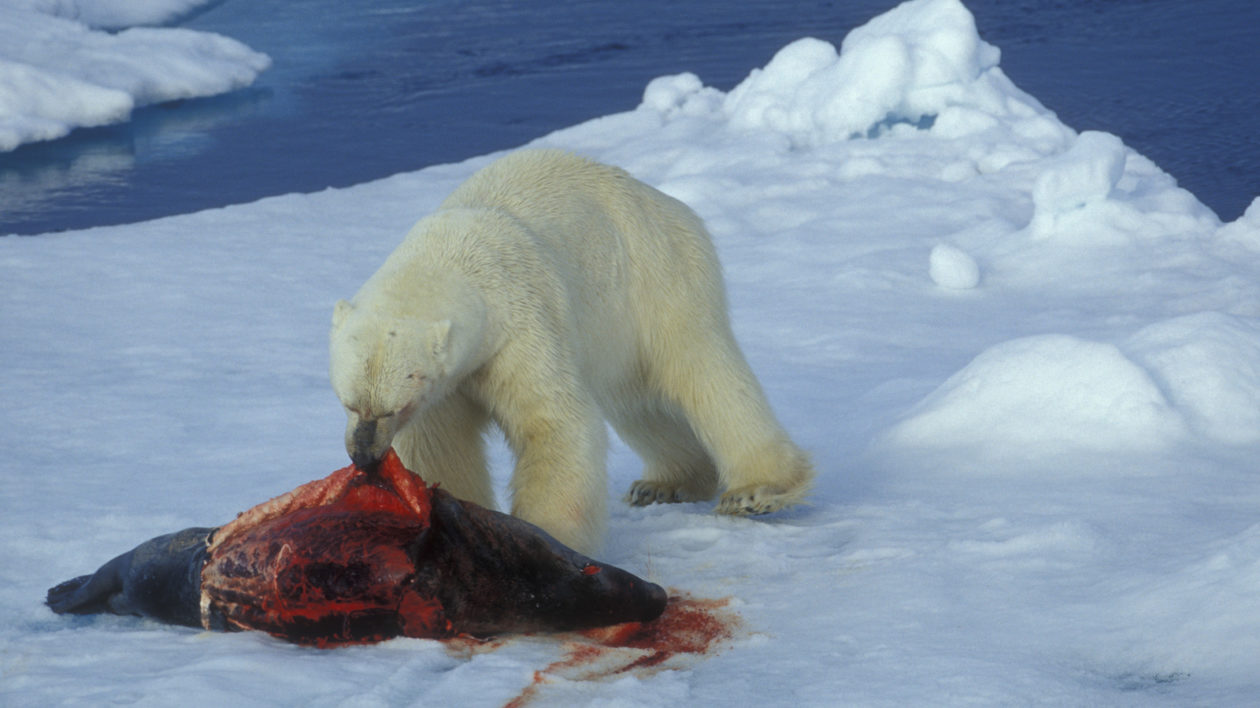
Unfortunately, hunting different prey on land isn’t enough to feed a hungry bear. In the lean summer months, bear do supplement their diet with food like caribou, berries, or bird eggs. But these foods don’t have enough calories to help bears build up their fat reserves, because bears have to expend more energy to find them.
It’s worth noting that — at least right now — not all polar bear populations are struggling to find food. Some parts of the Arctic still have year-round pack ice, while other areas are completely ice-free for several months. Nicklen, the photographer who captured the footage of the starving bear on Canada’s Baffin Island, told National Geographic that he has seen bears in Russia that are so fat they can barely walk. It all depends on the ice.
In places where the ice is disappearing fastest, bears are more and more likely to come into contact with people. The Russian town of Belushya Guba recently declared a state of emergency after an influx of more than 50 polar bears descended on the town in search of food. Photos show dozens of adults bears and cubs scavenging in the town’s rubbish dump and wandering playgrounds.
So just how many bears are starving right now? We don’t know. The Arctic is just too remote and too vast to monitor polar bears so closely. But Nicklen’s video and the ongoing invasion in Belushya Guba paint a worrying picture of what is to come as the sea ice slips away.
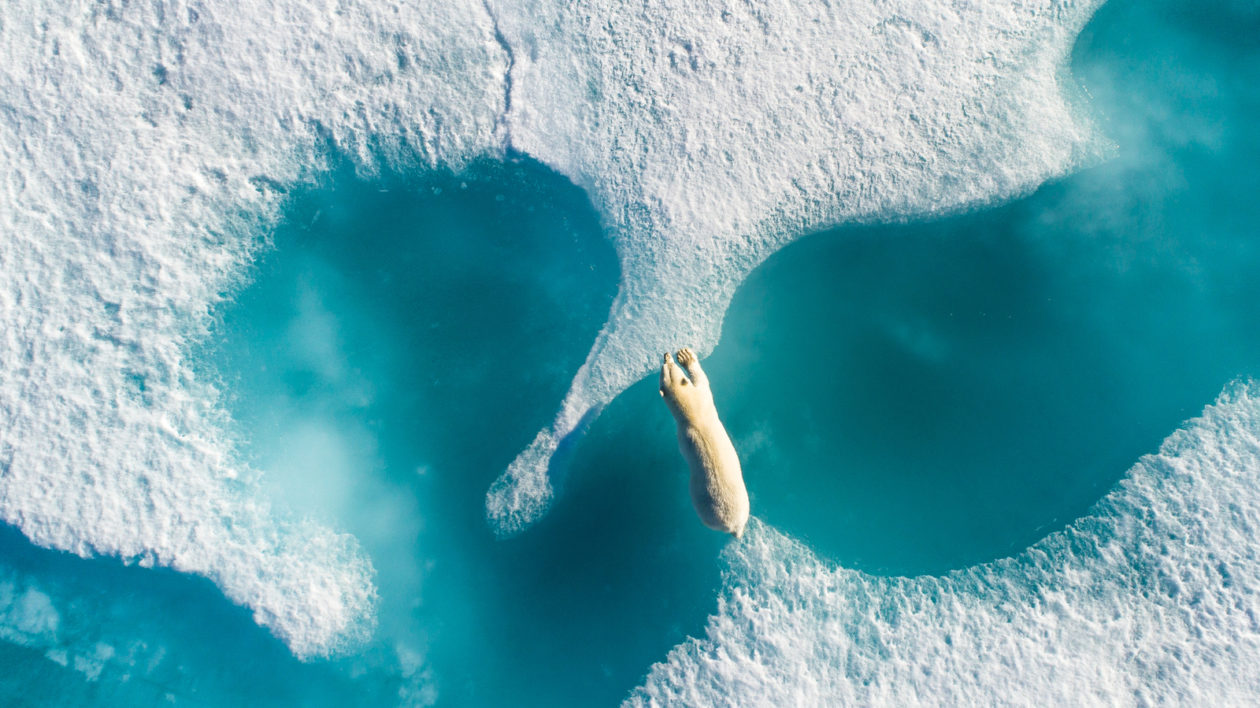
Will Polar Bears Go Extinct?
Maybe.
There are so many variables at play that scientists can’t say for certain if climate change will doom polar bears to extinction. But we do know that climate change will drastically and rapidly reduce the habitat that these bears need to survive. And that doesn’t bode well for bears.
A study on the Canadian Arctic Archipelago found that, under business-as-usual climate projections, polar bears may face starvation and reproductive failure across the region by the year 2100. Studies also show that polar bear populations will become more fragmented as ice declines, threatening their genetic health.
Another possible fate — and threat — is that polar bears will crossbreed with grizzly bears. Grizzly bears are venturing further and further north — likely because of climate change — bringing them into contact with polar bears.
Polar bears actually evolved from grizzly bears about 150,000 years ago, and they can still breed with this other species successfully. In the past 20 years, scientists and hunters have found a handful of polar-grizzly hybrids, called “pizzly” or “grolar” bears. While it’s not a widespread problem yet, conservationists worry that both hybridization and general competition with grizzlies could threaten polar bears in the future.
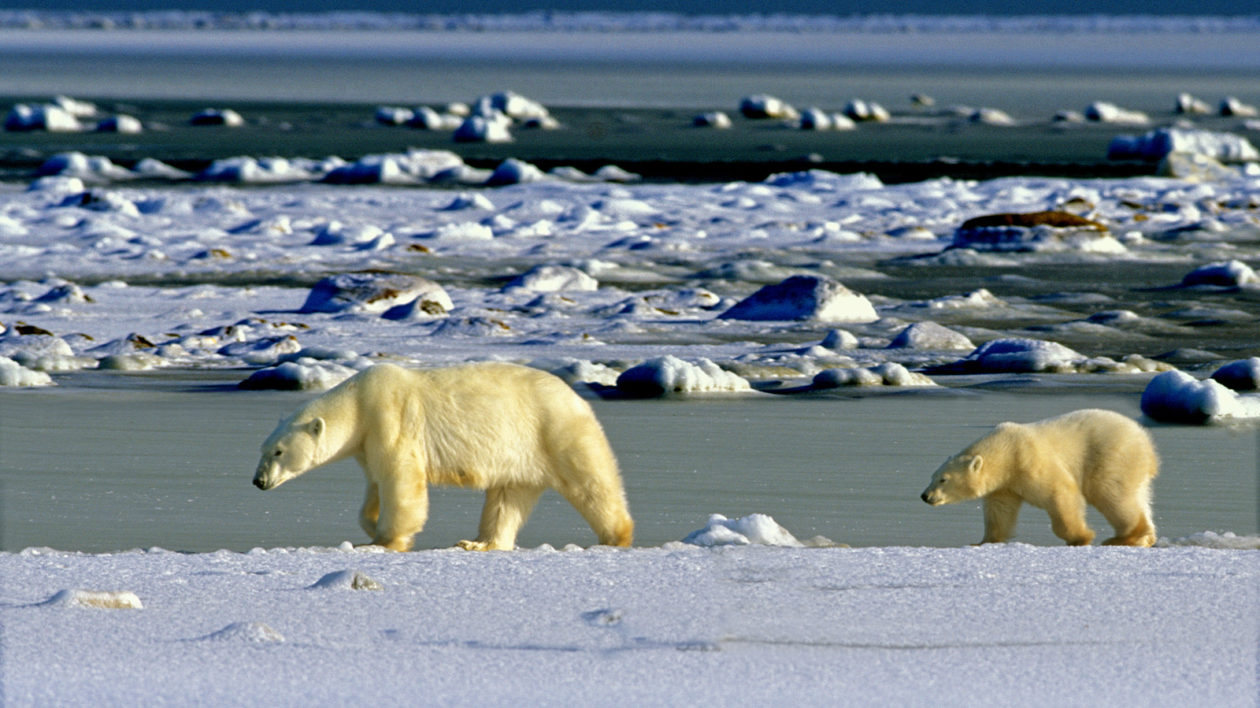
Can We Do Anything To Help?
Unfortunately, there are no quick fixes to save the polar bear.
Some people have raised the idea of relocating bears to Antarctica, or for feeding wild bears to help fight starvation. Both ideas are extremely problematic, expensive, and could cause lasting ecological harm for other species.
At the end of the day, these are just temporary solutions — the only way to protect polar bears long-term is to reduce greenhouse gas emissions. (You can read more about The Nature Conservancy’s efforts to fight climate change here.)
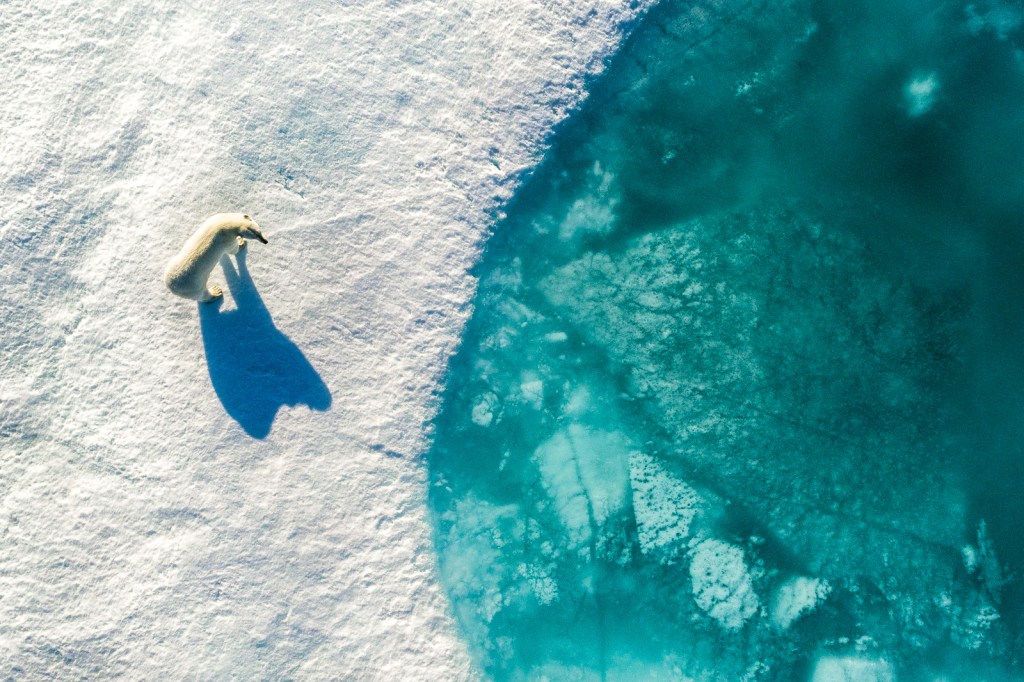



search for polar bear hunt in Canada (where most of them live) bear permits 1200.00 no way you will post this lol lol lol lol lol
WE NEED TO STOP DRIVING SO MUCH WE ARE MENTEL PEOPLE ALL OF US WE ARE KILLING INASINT LIVING ANIMALS!!!!!!!
I have the greatest respect for the scientists who do these studies but the are just that studies on paper they are projected thoughts and figures.
Why hasn’t someone actually tried to relocate several bears from the damaged areas, both adult sexually prime spieces plus some mothers with cubs.
Watch and study the effects on both the bears their food sources and the ecology in general.
All the supposition in the world counts for nothing.
I truly wish I had the money and expertise to do it.
No one country owns Antarctica so they should all help with the relocation and study expenses
Seals have to have something solid for raising young. They don’t have sea ice , they have land. The bear will follow.
Thank you Ronald! I hope that this is what will happen; nature constantly surprises me with it’s ability to adapt.
Recently I saw that a bunch of walruses were on a beach, hundreds or thousands of them, in fact there is a was a live web cam going, and they were on the beach because there was little ice for the animals, so if seals have to do the same then polar bears would only need to go over the the shore and gram a seal, that is if they can catch them fore they got back in the water. Note> I’m a sceptic actually, “climate change” is the wishywashy new name for global warming, which they had to coin when it didn’t warm up but cooled down so they had to capture both directions…I really don’t know but I think they could be right. The sun has a lot to do with it and destiny, glta!
If you were a real scientist WR. Youd know we are all screwed, so stop lyin your not fooling anyone here dude
The following statement found about half way through the article
“But since climate change is a human-caused problem . . .”
is oversimplified, misleading, inaccurate, and a typical alarmist rallying cry. The ‘climate’ on this planet has been changing for four and a half billion years and will continue to do so long after our species has caused its own extinction. Climate change is neither good nor bad – it is simply a natural process of the planet and our species cannot control it (if it could it would probably screw that up as well). Since humans as a species are egocentric and conceited if it is bad for us then it must be bad for the planet.
I am not saying that our species is faultless – science and history has shown that we are as culpable as any other natural process impacting the climate. Humans have not caused climate change – but we sure are accelerating the process in a direction that is not conducive to the survival of our species. Eliminating our carbon footprint will not stop climate change – we can slow down the change or speed it up but we can’t change it. In addition to our carbon footprint we have cut down so many forests and paved over so much prime rangeland that there is not enough vegetation left to balance out the carbon dioxide in the atmosphere – for those that are not up on their biology, plants take up CO2 and good old H2O, convert it to organic matter and release oxygen in the process. If all the governments and peoples on the planet got together behind a common cause (good luck with that) it would take more than a couple of decades to undo the centuries of harm our species has done to the planet. At best, humans might be able to stave off the inevitable long enough to figure out some other way to screw up the planet.
Yes – I may be a bit cynical, but I am a realist and a scientist. I take known facts and make logical extrapolations from the existing data. Give me more facts/data and I will revise my extrapolations. But for now, humans as individuals can be good and groups of humans can do amazing things (good and bad) – but generally as a species, humans are a planetary environmental disaster.
P.S. Feel free to bash me all you want – I only stumbled onto this site by accident and got disgusted by some of the comments I saw. I likely won’t be coming back in the foreseeable future.
I think its clear that the world has got a problem,
which is why I made this animation, to try and raise awareness of climate change;
https://www.youtube.com/watch?v=UjUVWICiH44
This website is awesome thanks keep the news coming!!!
Not the polar bears!!!!!!
If the sea ice should happen to disappear the seals will still be there but will rest on land rather as they do now on ice.
I have heard no claim that seals are in jeopardy due to any warming trend.
Hi Chip, thank you for the comment! I will look into this, I definitely read that some seal populations were moving north, but I didn’t do as much research on seals as on bears.
Hi Chip, sorry for the delay. Here is an IUCN summary of climate change effects on ringed seals http://cmsdata.iucn.org/downloads/fact_sheet_red_list_ringed_seal.pdf You might also be interested in the McKinney article cited above on the changes in polar bear diet for some discussion of changes to seal populations & more bibliography.
Thank you for your comment Scott. It is true that extinctions happen naturally, but there is evidence that the current extinction rate is higher than the “background” or natural extinction rate. See:
http://www.nature.com/nature/journal/v471/n7336/full/nature09678.html
http://wwf.panda.org/about_our_earth/biodiversity/biodiversity/
As you say, the polar bear is just one example and one that appeals to humans (charismatic megafauna). By getting people interested in saving these species and their habitat, we could save other, less charismatic, species that depend on the same habitat.
It’s difficult to face species extinctions within our time, particularly if our human impact is a significant, deciding or perhaps sole factor. It becomes more emotional the closer the species resembles us and our kindred species (pets & domestic animals).
It would be more challenging, no doubt, to raise awareness and action if we were discussing a sea slug two miles deep, or a tiny rodent in an obscure forest at the far flung edges of our world.
Fact is, the poles of our planet have been without ice before, and without polar bears. There was a time when North America was covered with a glacier a mile deep. This would be far from productive and sustainable for Grasshopper Sparrows and Ivory-billed Woodpeckers, though it did keep the Emerald Leaf Borer at bay (playing with timelines for dramatic purposes, these creatures may not have occupied the same epoch).
The whole truth is that more species have evolved and become extinct already than exist today. Furthermore, without their extinction this planet would either be overcrowded or inhospitable to humans, miniature-breed dogs and house cats, since there would be predators towering 30 feet outside the door.
Reality is, we wouldn’t be here in the first place, nor would polar bears, without the natural process of evolution, which includes necessarily in its plan, extinctions.
Scott R. O’Connor
Sharon Springs, NY
The plight of the polar bear under the pressure of anthropogenic global warming is one that is now a graphic test of the strength of our ethical commitments. Interspecies equity requires that we manage this earth in a way that keeps apex predators like the polar bear in a habitat suitable for them and their prey. If their habitat continues to contract and disappear, then at some point in the future, they too will become extinct. The Albrecht et al (2013)paper was written to encourage us all to contemplate the ethical extreme illustrated by, for example, the very idea of assisted relocation of polar bears to the Antarctic. If assisted relocation seems like an unethical and erroneous idea, then warming the climate such that will change ecosystems all over the world and endanger all species … is an unethical and erroneous idea.
Thank you for your comment Glen. I think that you put the ethical dilemma very well and I would encourage everyone to read the 2013 paper for a more complete discussion. I agree that warming the climate is unethical and has put mankind into an uncomfortable moral position – we must try to fix the problem, but in doing so, we must avoid creating further disasters for other people and the other species that share our planet. The best path forward at this moment is to stop emitting carbon, but getting that to happen globally will take a Herculean effort. I hope that learning about the plight of polar bears will push people to make that effort.
Yes Lisa, you are spot on. Our paper was all about the need for urgent mitigation so as to avoid the problem of assisted migration/colonisation in the first place. Your article highlights this point very effectively. Like you, I hope that people who read your article will realise that in the face of climate change … we are all polar bears!
hi lisa i think more people should do more donating to save the lives of the animals like polar bears
While climate change poses a significant threat to polar bears, in some areas hunting them is also a factor in their decline. If you have read some of the arguments from climate change skeptics about polar bear populations increasing, note that a) most populations are in decline, b) there is not very good baseline data on polar bear populations, c) the 1973 restrictions on hunting led to a rebound relative to the levels when they were more heavily hunted, and d) even where populations have increased, declining natality means that the population is expected to decline in the future (see http://rd.springer.com/article/10.1007/s10144-005-0231-2 for details). There is a good overview of this issue at http://www.skepticalscience.com/polar-bears-global-warming.htm
Thank you for your comment and the links Jon! I focused on the effects of climate for this post, but hunting certainly compounds the problem.
Hunting has zero detrimental effect on the polar bear,very limited numbers of bears are hunted,and the areas where they are hunted are managed for a sustainable harvest.
Hunters and hunting are not the enemy of wildlife conservation,we contribute far more in property acquisition money,habitat improvements,labor for habitat improvement,and have done more to re-establish species than any of the animal “rights” groups.
Hunters brought the wild turkey back from the brink of extinction,along with one group of hunters-Ducks Unlimited-bringing many species of waterfowl back from the brink of extinction,the same for the whitetail deer, elk, and moose,all big game in the U.S is managed for a sustainable harvest by hunters,the funding for the management comes entirely from hunters,through license and tag fees,along with the 11% excise tax on firearms and archery equipment-Pittman-Robertson Act)-the P-R funds provide billions for wildlife conservation.
The habitat improvements made by hunters/hunters groups/orgs benefit all wildlife,not just whatever species the improvements are designed to help recover.
Instead of blaming hunters and hunting for species decline,you may want to look at the facts-then you will discover that hunters are doing far more for wildlife conservation than any other group on the planet.